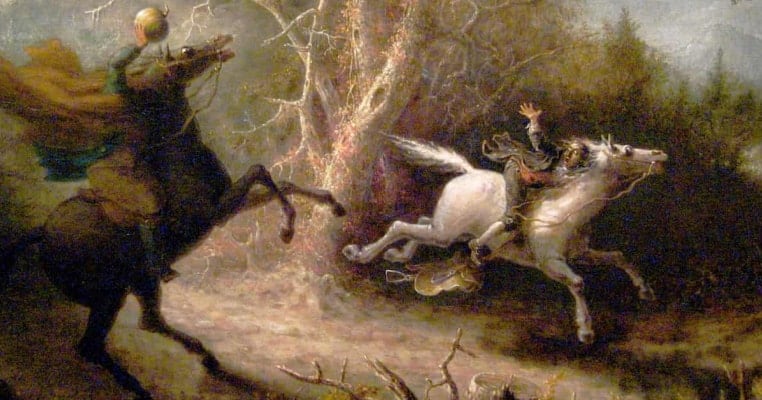The story of Ichabod Crane in The Legend of Sleepy Hollow has inspired the minds of many for over a hundred years. Washington Irving’s short story inspired films and a recent TV series, Sleepy Hollow. Ichabod was obsessed with Cotton Mather’s stories about ghosts and witchcraft, which Crane firmly believed to be real. Let’s look at the connections of Irving and Crane’s obsession with witchcraft, as well as the supernatural presence and homosexuality.
Ichabod Crane’s story is told through the papers of Diedrech Knickerbocker. Ichabod is from Connecticut, and is the head schoolmaster of Sleepy Hollow. He is described as a tall, skinny man and very stern when it comes to the schoolchildren. He falls in love and vies for the attention of Katrina Van Tassel, the daughter of a rich Dutch farmer. Brom Bones, the town hero, is also after her affections and beloved by the town even though he is a ruffian. Ichabod longs for the rich game land Katrina will inherit with succulent pigs, ducks, and other animals.
Ichabod attends a party at the Van Tassel home, where he proposes to Katrina after seemingly courting her, though Brom Bones was also trying to court her. Katrina turns Ichabod down, and he is sent home sullen and depressed when he hears a strange sound. At the party, many men told of ghost stories and the story of the Hessian Headless Horseman, a soldier in the Revolutionary War who lost his head due to a cannonball. Ichabod firmly believes the horseman is following him when the Hessian appears and chases Ichabod.

Ichabod believes that if he crosses the bridge by the church, the Hessian will disappear in a puff of fire and brimstone, just like the stories say. The Headless Horseman did stop at the bridge but threw his head at Ichabod causing him to blackout. The next day, after Ichabod didn’t show for school, the town went looking for him. The town found his hat and a smashed pumpkin head at the bridge lying in the water. He was never to be heard from again, though stories and myths floated down to Tarry Town that he was alive and became a politician, among other professions.
Society today, and in the past, believed women were the cause of supernatural happenings and witchcraft. Most literary texts that critics evaluate are the texts of the famous Salem Witch Trials in 1692. Vetere states that “The textuality of witchcraft is evidenced uncannily in writings on the Salem witch trials. Bernard Rosenthal writes that regardless of writers’ skepticism about witchcraft, its motifs, its literary conventions, if you will, draw them in inevitably.” (Vetere 123) Vetere is speaking about the gender ideologies that are present in these texts as well as other pre-19th-century literary texts. Literary texts that inspire ideologies of witchcraft invoke the reader, and can firmly enthrall them. These works are meant, as Rosenthal says, to draw them in.

